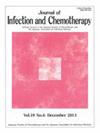hiv相关多中心Castleman病合并卡波西肉瘤:1例缓解后120周的HHV-8随访报告
IF 1.5
4区 医学
Q3 INFECTIOUS DISEASES
引用次数: 0
摘要
hiv相关的多中心Castleman病(HIV-MCD)是一种罕见的、危及生命的淋巴增生性疾病,以全身炎症和明显的淋巴结病变为特征。HIV-MCD的特征是人类疱疹病毒-8 (HHV-8)感染,尽管抗逆转录病毒治疗(ART)取得了进展,但其发病率仍在增加。虽然HHV-8病毒血症是疾病复发的公认指标,但干预低水平病毒血症再激活的必要性仍不清楚。我们报告了一例患有hhv -8相关HIV-MCD和卡波西肉瘤(KS)的男性患者,尽管偶尔发生低水平病毒血症,但患者获得了长期缓解。一名58岁男性未经治疗感染艾滋病毒,表现为发烧、盗汗和疲劳。组织病理学分析证实了HIV-MCD合并KS的诊断。他接受了利妥昔单抗、阿霉素脂质体和抗逆转录病毒治疗,缓解。患者随访120周,连续监测HHV-8 DNA水平。虽然偶尔观察到病毒血症,但未发生复发。当治疗后出现轻微的HHV-8再激活而没有临床复发时,我们避免了不必要的有潜在药物相关毒性的治疗。目前还没有针对MCD的预防措施,长期使用利妥昔单抗或缬更昔洛韦存在肺部和血液毒性的风险。因此,HHV-8 DNA监测和选择性干预似乎是可行的。及时诊断和免疫化疗,包括利妥昔单抗和多柔比星脂质体,是管理HIV-MCD并发KS的关键。这种组合缓解了KS的进展。HIV-MCD的成功管理需要早期识别和抗逆转录病毒治疗和靶向治疗,这可以导致持续的缓解。密切的HHV-8 DNA监测和临床评估减少了额外治疗的需要,强调了在个体化HIV-MCD管理中平衡疗效和安全性的重要性。本文章由计算机程序翻译,如有差异,请以英文原文为准。
HIV-associated multicentric Castleman disease with Kaposi sarcoma: A case report with 120-week follow-up of HHV-8 after remission
HIV-associated multicentric Castleman disease (HIV-MCD) is a rare, life-threatening lymphoproliferative disorder featuring systemic inflammation and marked lymphadenopathy. HIV-MCD is characterized by a human herpesvirus-8 (HHV-8) infection, with an increasing incidence despite advances in antiretroviral therapy (ART). Although HHV-8 viremia is a recognized indicator of disease recurrence, the necessity of intervention for low-level viremia reactivation remains unclear. We present a case of a man with HHV-8-associated HIV-MCD and Kaposi sarcoma (KS) who achieved a prolonged remission despite occasional episodes of low-level viremia. A 58-year-old man with untreated HIV infection presented with fever, night sweats, and fatigue. Histopathological analysis confirmed the diagnosis of HIV-MCD with KS. He received rituximab, liposomal doxorubicin, and ART which induced remission. The patient was followed for 120 weeks with serial monitoring of HHV-8 DNA levels. Although occasional viremia was observed, no relapse occurred. When mild HHV-8 reactivation occurred post-therapy without clinical relapse, we avoided unnecessary treatments with potential drug-related toxicities. No established prevention for MCD flares exists, and prolonged rituximab or valganciclovir use risks pulmonary and hematologic toxicity. Thus, HHV-8 DNA monitoring and selective interventions seem practical. Timely diagnosis and immunochemotherapy, including rituximab and liposomal doxorubicin, are critical for the management of HIV-MCD with concurrent KS. This combination mitigated KS progression. Successful management of HIV-MCD requires early recognition and administration of ART and targeted therapies, which can result in sustained remission. Close HHV-8 DNA monitoring and clinical assessment minimize the need for additional treatment, underscoring the importance of balancing efficacy and safety in individualized HIV-MCD management.
求助全文
通过发布文献求助,成功后即可免费获取论文全文。
去求助
来源期刊

Journal of Infection and Chemotherapy
INFECTIOUS DISEASES-PHARMACOLOGY & PHARMACY
CiteScore
4.10
自引率
4.50%
发文量
303
审稿时长
47 days
期刊介绍:
The Journal of Infection and Chemotherapy (JIC) — official journal of the Japanese Society of Chemotherapy and The Japanese Association for Infectious Diseases — welcomes original papers, laboratory or clinical, as well as case reports, notes, committee reports, surveillance and guidelines from all parts of the world on all aspects of chemotherapy, covering the pathogenesis, diagnosis, treatment, and control of infection, including treatment with anticancer drugs. Experimental studies on animal models and pharmacokinetics, and reports on epidemiology and clinical trials are particularly welcome.
 求助内容:
求助内容: 应助结果提醒方式:
应助结果提醒方式:


